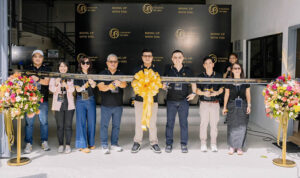The new Newfolk

In the time between its founding in 2015 and today, the design collective has changed both members and viewpoints
WHILE NEWFOLK held a preview on March 27 of their new exhibit of furniture and decor — the exhibit, No Boundaries, will run from April 5 to 12 at Comuna — it mostly served as a peek at the uniqueness of the next generation of Filipino industrial designers.
The exhibit was themed around a kitchen, then a café: Newfolk’s producer and creator Gabriel Lichauco said, “You don’t just cook there. It’s a place where we socialize… work. There’s always something new in the kitchen.”
Newfolk is a collective that first showed its work in Singapore Design Week in 2015. Back then, it was made up of Mr. Lichauco and his friends and colleagues: think Stanley Ruiz, Olivia d’Aboville, Rita Nazareno, and Wataru Sakuma (among others). Now, 10 years later, the collective consists of new designers, ranging in age from 25-30, some of whom Mr. Lichauco has nurtured while teaching at the De La Salle-College of St. Benilde.
At the preview, we saw a chair by Chini Lichangco, blossoming with magnolias. Selena Placino made a pegboard with batirol (chocolate whisks) pegs, as well as a lamp made of a rice funnel welded to a rice cooker. Razel Mari made a nest where one can store eggs, while we saw other goodies like mother-of-pearl salt and pepper dispensers and a knife block made of concrete and bamboo sticks (that hold the knives in place) by Krete Manila (Daniel Ubas and Viktoria Laguyo).
“I didn’t stop looking into how younger designers would progress,” said Mr. Lichauco.
He recalled that when he and his friends formed Newfolk, they were a little bit older than these new designers — they were then in their mid-30s and above, and had already made names in the industry. Project editor Anna Magsaysay-Rosete added that the OGs “all had some ties with places abroad,” pointing out, for example, that Mr. Lichauco had been working in Milan. These new ones, on the other hand, were mostly educated locally. “There are so many references that are local,” she said of the items in the exhibit.
Of the differences between the collective’s first designers and the new ones, Mr. Lichauco said, “We would be referencing what we saw abroad — what we were exposed to. These guys, they’re using very local references.”
The differences between old and new were also shaped by the COVID-19 pandemic’s influence on their early working years. “It’s really something that informed the generation,” Ms. Magsaysay-Rosete said. “During the pandemic, there was so much emphasis on the home, but also, they were all able to create.”
“The rigor is amplified, and then translated into different media,” she said. She pointed out the pedestals where pastries for the event were displayed: Bianca Carague made these from a digital world she created, then made forms out of them. In turn, the pastries were also designed digitally.
They also noted the differences between how their generation and the new Newfolk work. Mr. Lichauco said of the young ’uns, “They’re open to sharing ideas.” Ms. Magsaysay-Rosete said that before, design was a much more solitary experience. Now, after a pandemic that disconnected people, “They’re very much more aware and wanting to collaborate,” she said.
“Plus also the idea that something has to be sustainable.” She pointed out a collection of drawer pulls and knobs by Eldry John Infante and Martin Quiambao under Mese Studio in collaboration with Lamana: shaped like asterisks, they are made from wood off-cuts.
Furthermore, the Filipino identity in them is stronger, Ms. Magsaysay-Rosete says. “We were still really trying to define what is Filipino [back then]. But for them, they’re coming into it with a stronger identity than I would say, myself.”
No Boundaries can be seen at Comuna in 238 Pablo Ocampo Sr. Ext. in Makati from April 5 to 12. — Joseph L. Garcia




